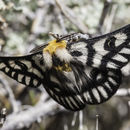Conservation Status
provided by University of Alberta Museums
More survey work is needed to determine this species' status in the province.
- license
- cc-by-nc
- copyright
- University of Alberta Museums
Cyclicity
provided by University of Alberta Museums
The single AB record is from mid-August. Dates from Montana suggest peak activity is in early August
- license
- cc-by-nc
- copyright
- University of Alberta Museums
Distribution
provided by University of Alberta Museums
There is only one record of this species for Alberta, from Dinosaur Provincial Park. It almost certainly occurs in the southeast corner of the province, because it is known from Govenlock, SK near the AB/SK border. Ranges from southern SK west to B.C., south to Arizona and New Mexico.
- license
- cc-by-nc
- copyright
- University of Alberta Museums
General Description
provided by University of Alberta Museums
A relatively large moth, easily recognized by the black pattern on the white background. The only other species similar to this in Alberta is H. eglanterina, which has a pink and yellow ground colour, not white.
- license
- cc-by-nc
- copyright
- University of Alberta Museums
Habitat
provided by University of Alberta Museums
Look for in the prairie region where sagebrush (Artemesia cana) is common.
- license
- cc-by-nc
- copyright
- University of Alberta Museums
Life Cycle
provided by University of Alberta Museums
Not known for AB; may have a two-year life cycle, overwintering first as an egg, then as a pupa. These moths are active during the day and are not attracted to light.
- license
- cc-by-nc
- copyright
- University of Alberta Museums
Trophic Strategy
provided by University of Alberta Museums
Larvae feed on Sagebrush (Artemisia tridentata, A. filifolia) in the southern U.S. Likely Artemisia cana in AB, as this is the only Sagebrush species found on the prairie.
- license
- cc-by-nc
- copyright
- University of Alberta Museums
Hemileuca hera
provided by wikipedia EN
- license
- cc-by-sa-3.0
- copyright
- Wikipedia authors and editors
Hemileuca hera: Brief Summary
provided by wikipedia EN
Hemileuca hera, the sagebrush sheep moth or Hera buckmoth, is a moth of the family Saturniidae. The species was first described by Thaddeus William Harris in 1841. It is found in North America from southern Saskatchewan west to British Columbia, south to Arizona and New Mexico.
The wingspan is 71–93 mm. Adults are on wing from July to September depending on the location.
The larvae of Hemileuca hera hera feed on Artemisia tridentata, A. tripartita, Lupinus and Eriogonum. The larvae of Hemileuca hera marcata feed on A. tridentata.
- license
- cc-by-sa-3.0
- copyright
- Wikipedia authors and editors

